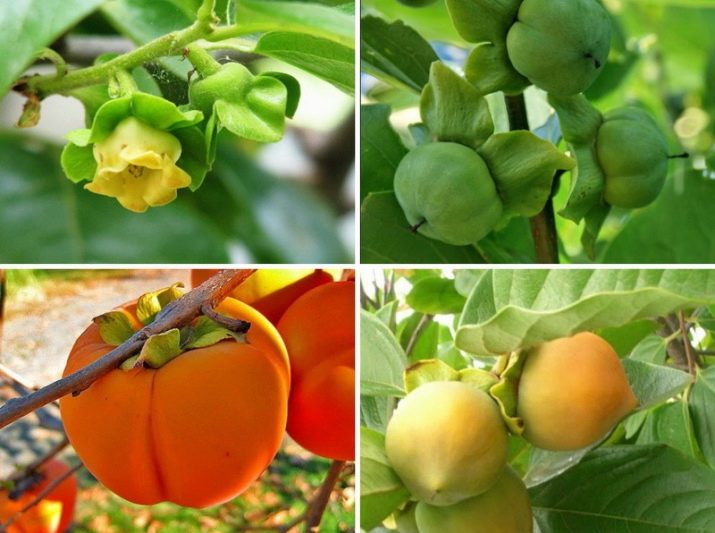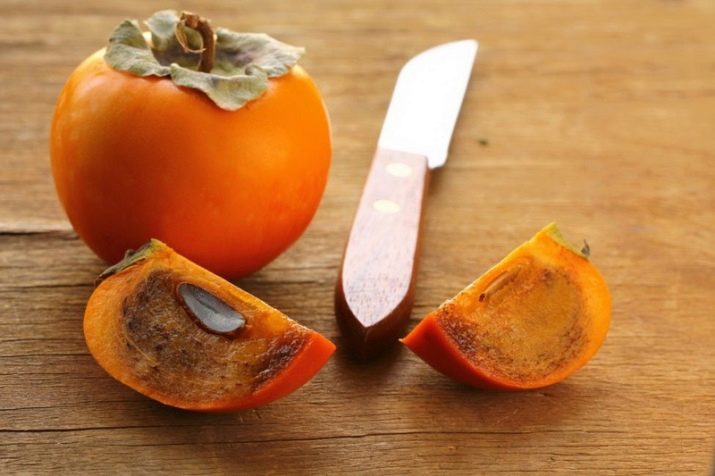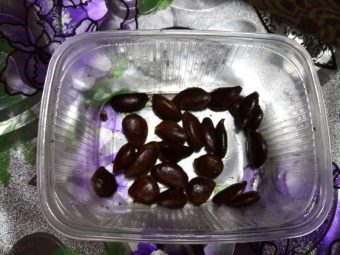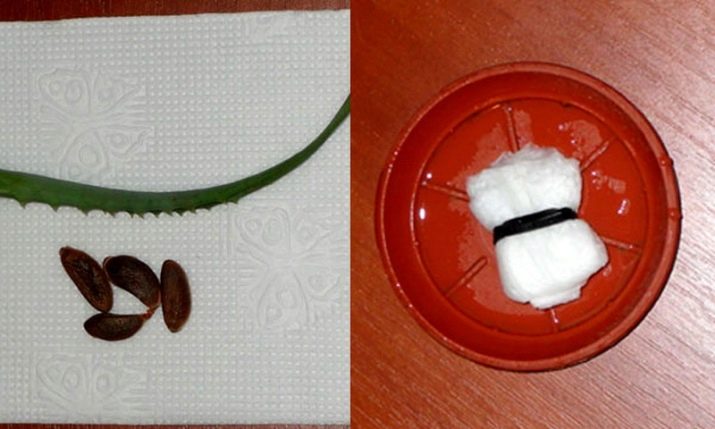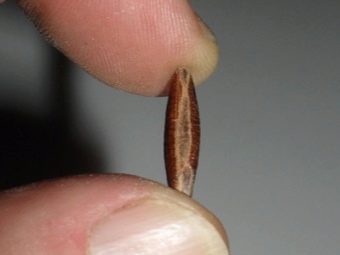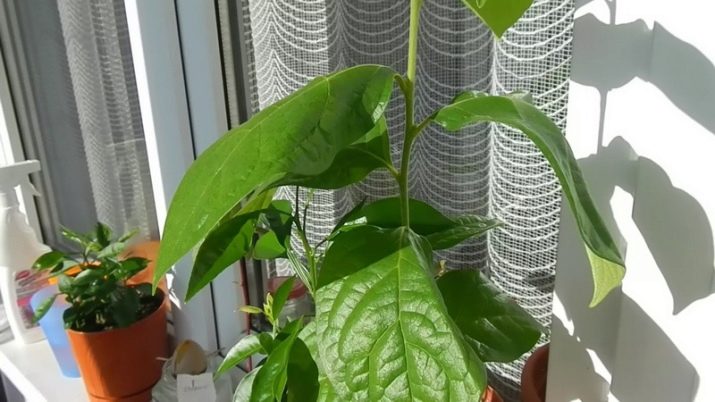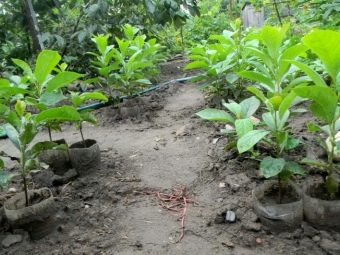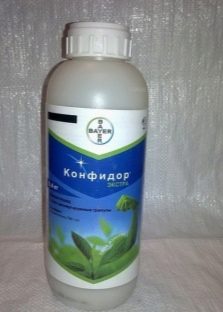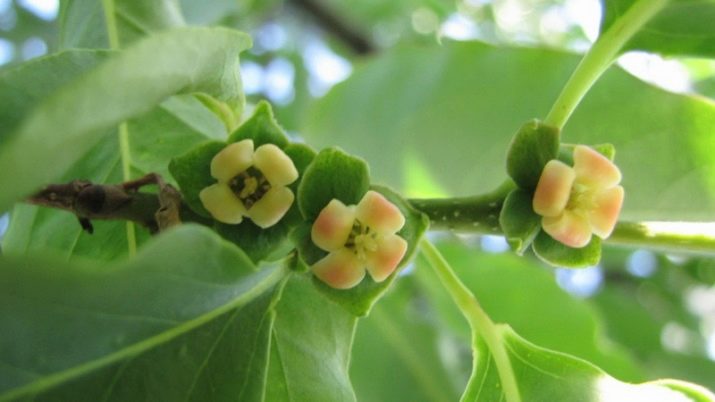How to grow a persimmon from the stone?
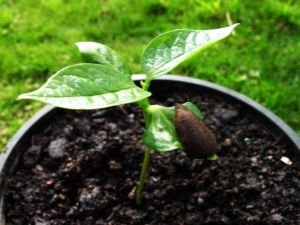
For a great many of our compatriots, persimmon remains an exotic fruit from the south, which can only be bought on the market or in a store.However, the most enterprising gardeners have long developed a way to grow such a plant even from an ordinary stone, without buying anything but fruit. Although persimmon is still a wonder, it is not too late to be original and free to enjoy tasty and healthy fruits from your own tree.
Features of culture
Persimmon is a very extensible concept, since this name is inherent in about a thousand species of such a plant, which looks like a shrub or small tree, can be evergreen or deciduous. Tree species have a volumetric crown, resembling a ball in shape, and their lifespan can reach several hundred years. The picture is complemented by leaves with a characteristic oval shape and a pronounced green color.
Under natural conditions, persimmon begins to bloom in May, and fruits can be collected at the end of autumn - usually not earlier than the end of October. The result of the gardener's works are all familiar large fruits, characterized by an expressive orange color. Outside, the persimmon fruit is covered with thick skin; as for the pulp, it is fleshy and very juicy. In our area, persimmon is considered to be tart, but this flavor indicates the immaturity of the berry - when ripe, it loses its knitting notes and becomes sweet.
If we consider the benefits and harm of such a berry, then the first, of course, more. Even the abundance of sugar does not make high-calorie persimmon, but it, as befits a tropical fruit, contains a lot of various vitamins and minerals needed to maintain good health. This fruit is recommended for those who have a lack of iodine in the body, it is also good as a rejuvenating agent and is a cancer prevention.
Unlike many other products, persimmon is allowed and even recommended for use by pregnant women, and it is recommended to inject it into the children's diet from the age of three.
Of course, completely harmless food does not exist, and although for a healthy person there will be no harm from eating persimmon, there are diseases that are a contraindication for including this berry in the diet. Such diagnoses include diabetes and obesity, as well as pancreatic pathology. It is also not recommended to abuse this fruit, because it provokes constipation, and in particularly severe cases - intestinal obstruction.
For our territories, such a plant is still atypical, but in general, its distribution area is vast - it grows throughout the subtropical and tropical zone on any of the continents except Antarctica. For normal growth, appropriate conditions are needed, namely, plenty of heat and sun, as well as regular watering. At the same time, persimmon does not put forward practically any requirements for the soil, and if in all other respects the necessary conditions are met, up to one hundred kilograms of fruits from one plant can result.
How to prepare the seeds?
At home, it is best to grow Caucasian varieties of persimmon, as such is slightly more adapted to the conditions of the middle zone. However, berries are often brought from there, so there will be no problem with choosing a fruit. Each copy contains up to ten grains, but at the same time for a potential planting it is necessary to choose ripe persimmon, which is distinguished by a clean skin without stains and soft pulp.
The fruit must be carefully disassembled, taking out the seeds from it. The latter must be thoroughly washed and then dried to avoid potential rotting at any of the stages. Dried seeds are disinfected by daily soaking in a solution of potassium permanganate, while seeds that are suitable for cultivation are necessarily drowned, and what emerged can be immediately thrown away.
The process of persimmon sprouting is rather complicated, therefore it is impossible to do without stratification.Experts recommend before it specifically with the help of fine-grained emery paper to grind the most hard edges of the bones, because they can prevent the plant from hiding. After that, the grains are soaked with growth stimulants. As such, you can use both chemical agents like epin and natural aloe juice.
The processed material should be wrapped in wet gauze and stored for about 6-7 weeks at a temperature of 4-5 degrees above zero - a refrigerator would be best for such purposes.
How to plant?
Since the plant belongs to heat-loving, it is out of the question to plant it immediately on the street in the middle lane. Stratified seeds begin to be planted in pots at approximately the end of February or the beginning of March. For growing seedlings of persimmon optimally fit capacity of average volume.
Although the plant is supposedly unpretentious to the composition of the soil, it is often advised to use sand and peat mixture. At the bottom of the pot is recommended to fill vermiculite, which will ensure proper drainage.
What is interesting is that it is necessary not only to bury a seed into the ground, but by placing it on an edge, the probability of germination of a seedling from a stone increases significantly. The depth usually should be equal to the length of such a grain - usually we are talking about about two centimeters.
A pot planted with a bone must be closed with a film in order to provide the future tree with an optimal microclimate. Ideally, the temperature of the soil should be about 22 degrees Celsius, which is normal for the house, but the room temperature can be additionally secured by placing the pot next to the radiator.
A potential plant needs to be watered regularly before it dawns, but here it is important not to overdo it, because often the soil is sprayed only superficially. Under the film a pronounced greenhouse effect is formed, which carries a certain danger to persimmon, because the condensate must be removed regularly, and the soil must be allowed to ventilate sometimes.
If all conditions were met, the future tree should germinate within a month. By the time the sprout begins to rest on the covering film, the solid seed coat is usually discarded, but if a young plant does not cope with this task, it needs help, otherwise there will be problems with the growth of the root system. For such a fine operation, tweezers are commonly used.
When the plant has risen, the vessel with it is placed on a well-lit place, however, it is desirable that the falling sun rays are not direct, otherwise they can dry the escape.
As is the case with most cultivated plants, it is possible to contribute to a more rapid development of seedlings, if you use the appropriate fertilizers. In the early stages, nitrogen-containing mixtures will be most appropriate, which must be introduced strictly in the amount indicated on the packaging.
Care Tips
For sprouted seedlings, you need to actively care for, otherwise the fact that it sprouts may be the last success in the cultivation of persimmon. If the initial cultivation allows for planting a significant amount of seeds in one pot, then in the future, stronger specimens must be transplanted so that each grows in a separate container. Usually, it takes about a week and a half to become young shoots, after which it can be planted.
The growing conditions of each individual fully grown specimen are quite similar to those required for germination, but instead of a film, for obvious reasons, a volume glass cap is used.
It is impossible to grow persimmon, ignoring regular watering, but this plant does not like marsh conditions. The soil in the pot must be constantly kept wet, but the accumulation of water in its thickness is unacceptable. To avoid such negative phenomena, it is advised to use mulch from sawdust. At the same time for watering need to use water at strictly room temperature.
Fertilizers should be used to accelerate growth. You can feed young persimmon with both purchased mineral fertilizers and home-made natural ones - for example, you can use egg broth or aloe juice diluted with boiled water. If we talk about mineral remedies, the most important thing is to give the tree phosphorus and potassium - these minerals are necessary for full fruiting. It is also appropriate to use special mineral complexes produced for fertilizing flowering plants.
Regardless of the age of the plant, top dressing is produced only in the warm season and no more than once every two weeks, while the fertilizer is always applied to the pre-moistened soil.
Although the persimmon is very fond of the sun, at first it is completely unacceptable to expose it to the sun. If the plant is planned to be planted once in the country, for a start it should be taught to an abundance of light - for this, on a cloudy day, seedlings are carried out to the balcony, starting with several hours a day and gradually increasing the duration of such periods. If all the windows of an apartment overlook the sunny side, it is possible to set seedlings on the window sill only by shading the window with a special film.
In winter, the plant needs less bright light - enough and diffused, but if the light period in this region is too short, it is worthwhile in the mornings and evenings to hold two-hour artificial light sessions for seedlings.
As for the temperature, the seedlings turn out to be the most fastidious, for which a temperature above 20 degrees of heat is necessary, but an adult plant turns out to be more robust - it will be enough for 15 degrees for normal life. At the same time drafts for persimmon are deadly.
In winter, the plant’s vital activity freezes, due to which it does not die even at 5 degrees Celsius, but it is desirable that the temperature does not fall below such a mark. To this end, the surface of the soil around the trunk is usually sprinkled with sawdust.
The formation of the crown of persimmon must begin quite early - even when reaching a height of half a meter. Pinching is a must-have procedure, since the crown must be branched and voluminous, and the newly formed shoots, in turn, also pinch when they reach 20-40 cm in length. Thanks to such a procedure, persimmon may bloom for the third year, otherwise it will take longer to wait.
One and a half meter tree is cut so that its crown becomes a spherical shape - so all the branches get enough light and heat. It is necessary to thin the crown regularly, otherwise the branches will grow too thick and will interfere with each other.
Without a vaccination, persimmon may never start to bear fruit. The simplest scheme is quite simple - on a healthy shoot, at the base, cut off the ring of bark, which is then grafted onto the same place, but on the reverse side. The cut is isolated with a thick layer of food-grade waterproof film to protect the wound from loss of moisture and bacteria. Due to this procedure, the growth of the shoot slows down, in contrast to which all forces are directed to the formation of the fetus.
A tree grown from a stone begins to give fruit at about the seventh year of life, however, grafting a cutting of a tree that is already bearing fruit can speed up the harvest.
If your region is characterized by a relatively favorable climate, in May you can try to transplant the plant in open ground. To do this, in a place protected from drafts, they dig a hole half a meter in size by half a meter or a bit more.
If you plan a whole plantation of persimmon, you must keep the distance between the plants at least a meter, and preferably two.
In most parts of Russia, planting persimmon in open ground still looks out of place, so it is recommended to cultivate the plant as a pot crop.At the same time, it is recommended to take the plant to the fresh air for the summer period, and in some cases you can even plant a tree in the ground with a pot in order to carry it back to the house for the winter.
In this case, even in the process of home growth, persimmon will have to be transplanted several times. The fact is that the root system of a plant is quite ramified, however, “wrapping” the roots into a closer framework does not usually harm growth. In the first years of life, persimmon is transplanted into a new container annually, increasing its diameter by a few centimeters, while plants over five years old are transplanted only once every two years.
Diseases and pests
When growing at home in a pot, persimmon is rarely sick, but in the open field it can face various troubles. The most common problems are gray and root rot, powdery mildew and black spot, as well as bacterial cancer and scab.
At home, all these problems are unlikely, provided proper care, as a typical environment for the development of these diseases is, first of all, excessive humidity, for which on the windowsill would surely be watched more carefully. In the open ground, specific weather conditions can lead to excess moisture, and the spread of pathogens of these ailments is carried out with the help of birds and insects, which in garden conditions have full access to persimmon.
The cause of the infection can actually be even a strong wind and close proximity to the diseased tree. Fungal diseases are also a frequent response to the failure of thinning the crown and the abuse of nitrogenous fertilizers.
It is best to deal with the preventive measures described by the ills, which include regular pruning, ventilation, properly calculated lighting and watering. You can also spray the plant with 1% Bordeaux mixture or any other drug with a copper content - this procedure should be carried out before flowering and after it.
If the plant is still sick, the treatment of persimmon must be carried out with drugs that are divided into two main groups. "Topaz" and "Chorus" are used in the event that the tree has not yet bloomed, but if flowers have already appeared on it, Actofit or Impact, Fitosporin, Bicol or Topsin will cope better with the task. At the same time, those branches whose disease damage is too obvious are usually not trying to save - they are to be burned in order to avoid further spread of the infection.
If we talk about pests, then the most typical uninvited guests are the scout and the spider mite, which will get to the persimmon even in apartment conditions. You can even solve the problem with improvised means - for this, the leaves are rinsed with soapy water, and the next day the whole plant is washed in the shower, having previously covered the ground with a waterproof film. This procedure brings results if you perform it weekly for a month. Of the high-yield chemicals, “Aktara” is considered, the processing of which gives a positive result lasting two months.
In the open ground persimmon may be interested in much more numerous varieties of insects and mites, against which apply "Aktophyt", "Akarin", "Confidor-extra", and other insecticides and acaricides. Processing with such means is carried out in several stages: first, before the appearance of buds, then after flowering, and finally, before the appearance of fruits.
Spraying by any means is desirable to carry out in good weather, not different either in heat or excessive coolness, it is also advisable to choose a day without wind and precipitation.
Harvesting
Since persimmon is still a tree, you will have to wait a considerable amount of time before it begins to bear fruit.A plant grown from a stone does not differ in terms of its duration from those grown from a seedling, but flowering usually does not occur before the third year of persimmon’s life, and it is possible to eat fruits at all only in the seventh year.
It will not be possible to accelerate the first flowering, and there is no special point in this, but the appearance of the first crop can be accelerated due to grafting, the procedure of which was described above. Fruits will appear even earlier if a twig of a more mature plant is planted on a young tree, which had already borne fruit.
It should be understood that too much hurry with this is not worth it, because in the first years of its life the persimmon grows and develops. Fruiting takes a lot of energy from the plant, because an excessively early start of the beneficial activity of the tree will result in too small growth and small, not always tasty fruits, and this situation may never be corrected.
Traditionally, persimmon is harvested in November, but it all depends on the climatic and weather conditions in the region where the persistent grower lives, as well as on the specific conditions prevailing in his apartment. It should be noted that in some cases even in an apartment, persimmon will not normally bear fruit, because most of the species we grow for the winter fall into a kind of hibernation.
You can try to partially solve the problem by the method of artificial lighting and heating, however, if there is a suspicion that due to unsuitable conditions, you will have to take advantage of unripe fruits, it is often better to abandon the idea of growing persimmon to produce fruits.
How to grow a persimmon from the stone, see the following video.


